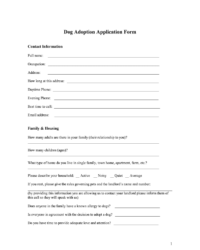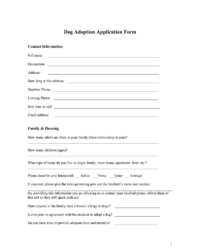Utilizing such a form streamlines the adoption process, enabling shelters to efficiently assess applicants and make informed decisions. This benefits both the animals, by increasing their chances of finding stable and loving homes, and the adopters, by providing clarity and transparency throughout the process. The structured nature of these forms also allows for easier record-keeping and data analysis, aiding shelters in improving their adoption practices.
The following sections will explore the key components of these valuable resources, offering guidance for both shelters developing their own forms and individuals preparing to adopt a companion animal.
Key Components of an Animal Adoption Application
Effective applications gather comprehensive information to ensure successful animal placements. Several key components contribute to this goal.
1: Contact Information: Full name, address, phone number, and email address are essential for communication and follow-up.
2: Lifestyle: Questions regarding housing type (house, apartment, etc.), yard space (fenced or unfenced), and activity level within the home provide insights into the environment the animal would be entering.
3: Pet Ownership History: Details about current and previous pets, including species, breed, age, and veterinary care history, offer valuable context about an applicant’s experience and commitment to animal welfare. Reasons for previous pet relinquishments, if any, are also typically requested.
4: Experience with Specific Species/Breeds: Assessing an applicant’s familiarity with the particular animal’s needs helps ensure a good match. For example, experience with high-energy breeds or animals with specific behavioral needs may be crucial.
5: Family Information: Presence of children or other adults in the household, along with their ages and any relevant experience with animals, helps determine suitability and safety.
6: Landlord/Housing Restrictions: Securing permission for pet ownership, especially in rental properties, is essential. Applications often request landlord contact information to verify pet policies.
7: Veterinary References: Contact information for previous or current veterinarians can provide valuable insights into an applicants pet care practices and adherence to recommended medical protocols.
8: Adoption Preferences: While not always a requirement, allowing applicants to express preferences regarding age, breed, size, or temperament can facilitate a more seamless matching process.
Thorough data collection through these components allows shelters to evaluate applicants effectively and make informed placement decisions that benefit both the animals and their potential adopters.
How to Create an Animal Adoption Application Template
Creating a comprehensive adoption application is crucial for animal shelters and rescue organizations. A well-designed application gathers essential information, facilitating responsible pet placements and successful adoptions.
1: Define Objectives: Clearly outline the information needed to assess applicant suitability. Consider the specific needs of the animals in the organization’s care.
2: Structure the Application: Organize the application logically into sections (contact information, lifestyle, pet history, etc.) for clarity and ease of completion.
3: Craft Clear Questions: Use concise, unambiguous language to elicit specific information. Avoid leading questions and ensure questions are relevant to responsible pet ownership.
4: Include Essential Components: Incorporate sections for contact details, lifestyle information, pet ownership history, veterinary references, and landlord permissions (if applicable).
5: Consider Specific Needs: Tailor questions to account for the unique needs of different species or breeds. For example, applications for high-energy dogs might inquire about exercise routines.
6: Obtain Legal Counsel: Review the application with legal counsel to ensure compliance with relevant laws and regulations regarding data privacy and discrimination.
7: Test and Refine: Pilot the application with a small group and gather feedback. Revise the application based on feedback to improve clarity and effectiveness.
8: Make it Accessible: Offer the application in various formats (online, printable) to accommodate different applicant preferences. Ensure readability and accessibility for all.
A thorough, well-structured application serves as a vital tool for responsible pet placement, promoting successful, long-term adoptions and the well-being of animals.
Standardized forms for animal adoptions serve as crucial instruments for shelters and rescue organizations. These applications facilitate thorough applicant assessments, enabling informed decisions that prioritize animal welfare and successful placements. By gathering comprehensive data regarding lifestyle, pet ownership history, and other relevant factors, these tools contribute significantly to responsible adoption practices.
Ultimately, the diligent use of these resources promotes the well-being of animals by connecting them with suitable, loving homes. Continued refinement and adaptation of application processes, based on evolving best practices and community needs, will further enhance the effectiveness of adoption programs and contribute to a more positive future for companion animals.


